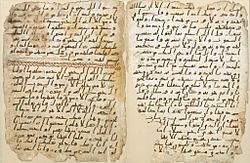Birmingham Quran manuscript facts for kids
Quick facts for kids Birmingham Quran manuscript |
|
|---|---|
| Cadbury Research Library, University of Birmingham | |

folio 1 verso (right) and folio 2 recto (left)
|
|
| Date | Between c. 568 and 645 |
| Language(s) | Arabic |
| Scribe(s) | Unknown |
| Material | |
| Format | vertical |
| Script | Hijazi |
| Contents | Parts of Surahs 18 to 20 |
| Accession | 1572a |
The Birmingham Quran manuscript is a very old piece of writing on parchment (animal skin) that contains parts of the Quran, the holy book of Islam. It has two pages, called leaves, written in an early style. This special manuscript is kept at the University of Birmingham in the United Kingdom.
In 2015, scientists used a special test called radiocarbon dating to find out how old the parchment is. They found it was made between the years 568 and 645 CE. This means it could have been written during the lifetime of the Islamic prophet Muhammad or very soon after. The manuscript is part of a larger collection of Middle Eastern writings called the Mingana Collection.
The writing is in Arabic using an old style called Hijazi script. Even though it's very old, the writing is still easy to read. The two pages contain parts of three chapters (called Surahs) from the Quran: Surah 18 (Al-Kahf), Surah 19 (Maryam), and Surah 20 (Ta-Ha). The manuscript was shown to the public in Birmingham in 2015 and 2016. Experts have also used special cameras and X-rays to study the ink and parchment.
Contents
How the Manuscript Was Found
The Birmingham Quran manuscript is part of the Mingana Collection. This collection has over 3,000 old documents. It was put together in the 1920s by a person named Alphonse Mingana.
A rich businessman named Edward Cadbury helped pay for the collection. His family was famous for making chocolate in Birmingham. The manuscript was actually misidentified for a long time. It was mixed in with pages from another old Quran manuscript.
What the Manuscript Looks Like
The two pages of the Birmingham manuscript are quite large. They measure about 34.3 cm by 25.8 cm. Both sides of each page are written on. The writing is big and clear, making it easy to read.
One page has verses 17–31 from Surah 18. The other page has the last eight verses (91–98) of Surah 19 and the first 40 verses of Surah 20. These parts of the Quran are in the same order as they are in modern Quran copies.
There are no small marks to show short vowels in the writing. However, some letters have small dashes to tell them apart. The text is set up like later Quran copies. It has decorated lines to show where chapters begin. Dots are used to mark the end of each verse.
The words in the Birmingham manuscript are almost the same as in today's standard Quran. But there are small differences in how some words are spelled. For example, the silent letter 'alif' is sometimes missing. This was common in very early Arabic writing. Scientists have also checked the pages with ultraviolet light. They confirmed that there is no older writing underneath. This means the parchment was not reused.
Why the Manuscript Is Important
The age of the Birmingham Quran manuscript is very important. The radiocarbon dating suggests it was made between 568 and 645 CE. Prophet Muhammad lived from about 570 to 632 CE. This means the manuscript could have been written when he was alive or very soon after his death.
According to Islamic tradition, the first leader after Muhammad, Abu Bakr, helped gather the Quran's verses. Later, the third leader, Uthman, created a standard version of the Quran. He also ordered that other versions be destroyed.
Many experts believe this manuscript supports the idea that the Quran's text has stayed mostly the same over time. David Thomas, a professor at the University of Birmingham, said that the text is "very close to the form of the Qur’an read today." This suggests the text has not changed much.
However, some experts have different ideas. They point out that the manuscript has chapter divisions and verse-end dots. They believe these features were added to the Quran later, not in the very first copies. They also note that radiocarbon dating tells us when the animal lived, not exactly when the writing happened. Parchment could be stored for years before being used. So, the manuscript might have been written a bit later, perhaps during Uthman's time.
Despite these discussions, the Birmingham Quran manuscript is a truly amazing discovery. It helps us understand the early history of the Quran and its text.
Images for kids






